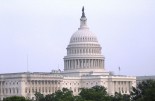Payden & Rygel: The week ahead in US economic news

Jeffrey Cleveland, Chief Economist at Payden & Rygel, comments on the week ahead in US economic news.
U.S. Treasury Bond Yields
Two-year Treasury bond yields are close to 4, 4.1% at the end of last year/the beginning of this year. Ten-year yields got down to around 3.80%. And when we look at Treasury yields last week, the two-year yield is closer to 5% and the 10-year yield has backed up quite a bit as well, up about 80 basis points. So, bond investors have completely reassessed the path of overnight rates and the issue of inflation and pushed yields higher.
A lot of clients are saying, well, why do I need to be in risk — or risky assets, if you will — when I can earn a pretty good yield on a two-year treasury, almost 5% or even north of that on a three-month T-bill if you stay short. So, I think that’s having knock-on effects on all the other assets.
The U.S. Federal Reserve Bank
There was an expectation in the bond market for, call it seven rate cuts this year. That has been erased somewhat. Now the bond market is entertaining maybe one or two cuts later in the year. And the main consequence of that is that yields have drifted higher. So, I think that’s why you see your three-month Treasury bill above 5%. It’s a reflection of a repricing, if you will, of the Fed.
Why has that repricing occurred? Inflation is coming higher. So far this year we’ve had two or three stronger than expected inflation readings. Next week, the big event will be at the end of the week with the personal income and spending report. We’ll get the core personal consumption expenditures index (PCE), and that’s the all-important one. And month-to-month, the market is expecting a 0.3% reading. Maybe some upside risks there, but that will be a key thing to watch out for in the week — the week ahead.
I think 0.3% is a good bet for the PCE. The problem is 0.3 month-to-month percent change, if that were to persist for the rest of the year, would put upward pressure on core PCE. To be consistent with the Fed’s target, you need something closer to 0.2% or maybe even a little under 0.2%, in terms of the month-to-month percent change in the index. So, 0.3, although it doesn’t sound like much, if it’s maintained, it’s too high, it’s too much inflation. And that’s what the bond market is concerned about.
Geopolitical Situation
It’s tough with the geopolitical situation. Just looking at history, you’ve had several geopolitical surprise events tend — they tend to have relatively short-lived market impact. After three or six months, those impacts tend to fade. So, I don’t think as an investor you can focus too much on that. I mean, you have to keep it in mind on the short-term basis, but further out what’s going to matter is the pace of growth, the rate of inflation, where unemployment rate ends up, and then what the Fed does with the interest rates. Those tend to be, I think, the more important factors for driving, in particular, the bond market.
Inflation
As I said 0.3% for the PCE was too hot, or too high for the month-to-month reading. We need something closer to 0.2%. What do we need to see happen to get that slowdown? I think you could think of core inflation in three big buckets: Goods prices, housing, and then everything else. So, services, most of what you spend your money on. And goods prices have come down a lot. We’ve seen a good amount of disinflation there. I don’t know we’re going to get more help.
Where we could see more help is on housing. If rents were to cool off more substantially, that would help bring down overall inflation. I worry that rents are going to remain a bit stickier than people had hoped for at the start of the year, and that’s going to keep inflation more elevated. And then the same thing on the third category, services. So, roughly 50 to 60% of the core PCE are the non-housing services and that tends — that’s running at around 4% year-on-year, so way above the Fed’s target, and that tends to stay strong if the labor market stays strong.
So, if you have a job and you have money to spend, the American consumer does one thing very well, which is spend, and that keeps services prices elevated. My gut instinct here is that inflation stays a bit stickier than forecasters had expected, than policy makers had hoped for at the start of the year, and that keeps interest rates higher for longer.










